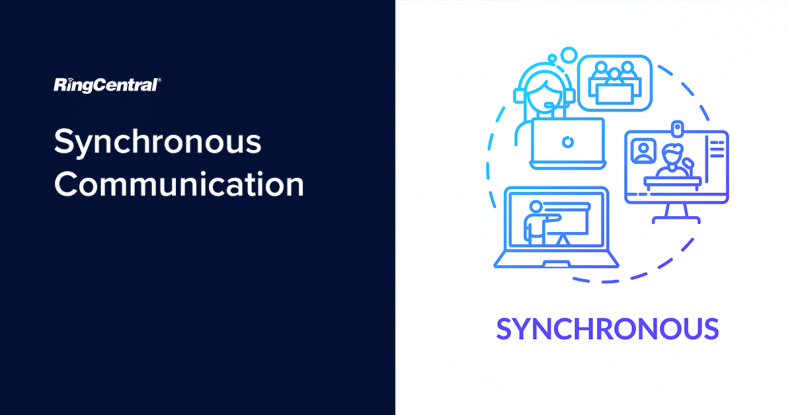In this article, we'll cover:
What is Synchronous communication?
Synchronous communications is that which takes place in real-time between two or more parties. Put simply; a synchronous communication exchange is an interactive, ‘live’ interchange between people. If you have ever attended a conference call (or indeed any phone call) or a video conference, you have engaged in synchronous communication. The nature of any synchronous type of communication necessitates an immediate response.
In a brick and mortar office environment, synchronous communication is common, whether that be a chat around the watercooler or your Monday morning team catch-up. Still, in an increasingly remote working environment, synchronous communication has taken more of a back seat. That’s because, when teams work around their own schedules, not to mention across different time zones, synchronous communications become harder to conduct.
The benefits of a Synchronous workplace
It’s fair to say, communication that takes place in real-time lends itself to building more authentic connections, more so than the fragmented back-and-forth of asynchronous communications.
Businesses that adopt a synchronous culture may see the benefits of a tight-knit, effective team.
There are types of communications or meetings that require a more synchronous approach. The immediacy of communication or collaboration tools are necessary for conducting the following forms of communication:
Brainstorming
The popular meetings method of brainstorming sessions probably wouldn’t have quite the same impact if they were conducted asynchronously. The nature of a brainstorm is usually quick, including uncensored ideas and inspiration with creative input required as an off-the-cuff, one-off event.
Team Building events
It probably goes without saying, team building requires face-to-face, real-time bonding. It’s much harder to build a genuine human connection with a stranger via instant messenger apps, so businesses wanting to conduct team building activities will need to find a way to conduct synchronous sessions ideally via a video chat (if an in-person meeting is not feasible).
Complex project discussions
Complex tasks and projects, as well as sensitive feedback sessions or urgent crisis meetings, should take place in real-time. Time-delayed written text messages are open for interpretations and miscommunications, so for complex training, briefings and task delegation, video conferences are best for retaining rapport and avoiding confusion.
One-to-one sessions
The nature of a one-to-one requires real-time communication and ideally a face-to-face exchange to support better interpersonal connections between colleagues.
Remote onboarding
In the event of remote onboarding, whether it be partner onboarding, client onboarding or employee onboarding, don’t devalue the importance of face time. Training sessions are also best delivered via live video calls ideally with a screen sharing element for elaboration on complex tasks. Having a physical person to connect with is especially important in case the participant has questions or feels isolated or excluded from their new team.
Difference between Synchronous & Asynchronous Communication
Asynchronous communication means participants of discourse don’t have to respond immediately. With Synchronous communications, conversations happen instantaneously rather than the fragmented conversational snippets of email or online chat.
Asynchronous transmission might take place via communication channels such as RingCentral messages, email exchanges or messaging via a project management tool such as Trello or Asana. Synchronous communications might take the form of a video meeting or a phone call to a colleague on a mobile device.
Essentially, in synchronous communications, participants are present and are expected to respond almost instantly, whereas, with asynchronous communications, they have a little time to address their correspondence and craft a response.

Synchronous Best Practices for Distributed Teams
Working as part of a distributed team has its perks and its pitfalls. A synchronous culture can help with aspects such as loneliness and efficiency. Here are a few ways organisations can make the most of synchronous communications in the virtual workspace.
-
Strike the right balance
Synchronous and asynchronous communications have significant differences, but they shouldn’t work in isolation. While brainstorm sessions, for example, are much more effective as a synchronous approach, those needing to conduct deep work daily will need to adopt an asynchronous approach too. That means business leaders and team leaders need to find the right combination, laying downtimes for uninterrupted work and face to face meetings respectively as per the needs of their teams.
-
Use the right tools
Striking that perfect balance also means you’ll need a technology stack that enables both asynchronous exchanges and synchronous discourse daily. Project management tools such as Monday.com and tools that help to automate and manage workflows such as Process.st can significantly aid productivity between teams. This combined with video conferencing software and instant messenger apps allow teams to choose the appropriate communication method for day-to-day tasks, reducing distractions but also getting valuable face time when they need it.
-
Set and respect boundaries
Establishing best practice rules for team engagement can be beneficial to help maximise productivity and improve work-life balance. Communication tools such as RingCentral allow users to set their presence and status updates, acting as a great way to let colleagues know whether you are available. Team leaders can encourage a culture of openness and flexibility by making sure employees feel comfortable asking colleagues to give them a little focus time.
-
Be mindful of different time zones
Remote teams need to pay particular attention to the local time zones of their colleagues. Asking staff to turn notifications off outside of office hours can help to encourage a healthier work-life balance and mitigate stress. Still, it’s good to be mindful of the local time your messages will land regardless. Naturally, it’s best to avoid real-time meetings until you can negotiate a time that works for participants in various time zones.
-
Encourage activities to avoid isolation
With isolation cited as one of the key challenges for remote workers, synchronous communication can become a key aspect to help mitigate loneliness. In addition to regular video meetings, team leaders can organise virtual teambuilding sessions such as virtual games nights or random team coffee mornings to encourage more of a sense of unity. The act of stepping out of the day-to-day work, talking about hobbies or simply getting to know one another better can help disparate team members to feel more connected with their team.
The Future of Remote Communication
In the UK alone, the number of remote workers grew by 25% from 2008 to 2018. These figures were reflected in the remote working landscape across mainland Europe as businesses discovered the incredible scope of the enabling technology we have at our fingertips.
The Covid-19 pandemic has flipped our perception of the traditional workplace on its head. With organisations thinking twice about committing to long-term office leases and business leaders opening their minds to the concept of a more efficient, more productive remote workforce, not to mention better scope for talent recruitment the business landscape has seen unprecedented change.
While predicting what the ‘new normal’ will look like is somewhat futile, businesses should focus on preparing and laying the foundations for a more permanent virtual workspace to allow for business continuity and resilience in a post-pandemic environment.
Investing in tools that allow for synchronous communications can support teams in fostering a sense of togetherness at a time when many of us are set to remain physically disparate.
Originally published Dec 08, 2020, updated May 20, 2021


